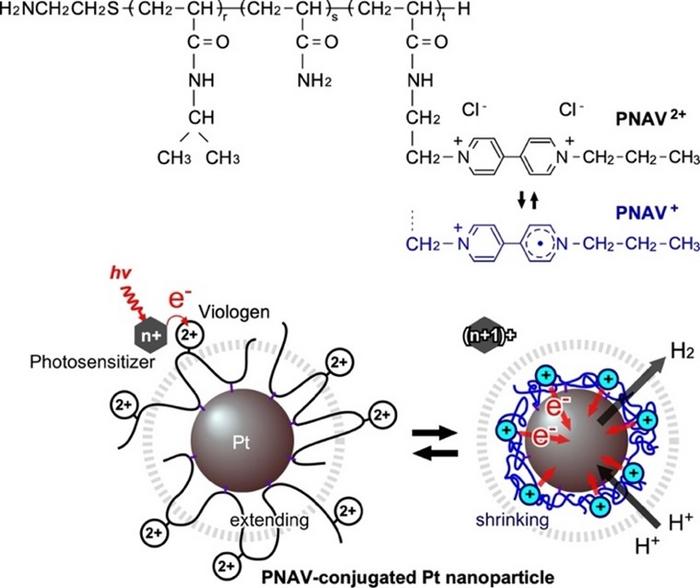Ishikawa, Japan — Various molecular systems have been developed by researchers for photoinduced (i.e., light-driven) electron transfer, including supramolecules, hybrid materials, and organic polymeric systems. While these systems fulfill the distance criterion required by the electron donor and acceptor for efficient electron transfer, they frequently fall short in accommodating molecular motion, especially in fluid environments. Is there a viable approach to design a system that facilitates electron transfer without succumbing to these limitations?

Credit: Kosuke Okeyoshi from JAIST.
Ishikawa, Japan — Various molecular systems have been developed by researchers for photoinduced (i.e., light-driven) electron transfer, including supramolecules, hybrid materials, and organic polymeric systems. While these systems fulfill the distance criterion required by the electron donor and acceptor for efficient electron transfer, they frequently fall short in accommodating molecular motion, especially in fluid environments. Is there a viable approach to design a system that facilitates electron transfer without succumbing to these limitations?
This issue has been specifically addressed in a recent study. A team of researchers from the Japan Advanced Institute of Science and Technology (JAIST), led by Associate Professor Kosuke Okeyoshi and including Associate Professor Shun Nishimura and Graduate course Student Reina Hagiwara, has now developed a copolymer-conjugated nanocatalytic system to enhance active electron transfer for increased photoinduced hydrogen generation.
Their study, published in Chemical Communications, aims to overcome the limitations of current photoinduced electron transfer systems. The objective of the researchers was to establish an efficient catalyst system capable of promoting electron transfer with only a minimum number of side reactions. Dr. Okeyoshi explains: “This system has potential real-life applications for the hydrogen economy. By integrating the system with an oxygen-generating system, photoinduced water splitting (artificial photosynthesis) is anticipated.”
In this regard, viologen is a well-known molecule that is both an efficient electron donor and acceptor. The researchers had previously exploited this property of viologen to develop an electron transfer system, which included the copolymer poly(N-isopropylacrylamide-co-Viologen) (PNV) and modified platinum nanoparticles (Pt NPs). In this system, the temperature-dependent phase transition in PNV responds to viologen’s redox changes, allowing for a cyclical electron transfer process for continuous hydrogen generation. However, while the PNVs near the Pt NPs participated in the electron transfer process, free PNV molecules situated farther away could also accept electrons.
To address this issue, the researchers have now designed a copolymer-conjugated nanocatalytic system using the ternary random copolymer poly(NIPAAm-co-Acrylamide-co-Viologen) or PNAV, which was synthesized by precisely controlling the molecular weight and introduction ratio of the polymeric units.
A notable characteristic of PNAV is its temperature-responsive behavior, marked by a phase transition dependent on temperature. This unique copolymer exhibits a discernible shift, oscillating between a swollen state in its oxidized form (PNAV2+) and a shrunken state in its reduced form (PNAV+). Additionally, the connection of PNAV to Pt NPs involves a reduction process, providing control over the distance between the viologen and the Pt NPs. Specifically, the precise swelling/shrinking of PNAV on the Pt NPs proves crucial to the success of the proposed cyclic electron transfer process at a given distance.
The present innovation leverages the advantages of a stimuli-responsive polymer chain to achieve dynamic electron transfer. The copolymer-conjugated nanocatalytic system not only holds promise for facilitating active electron transfer in photoinduced hydrogen generation but also demonstrates potential utility in artificial photosynthetic reactions, such as photoinduced water splitting. Moreover, this innovative approach is anticipated to have broader applications beyond photochemical reactions to encompass various domains, including electrochemical reactions and macromolecular recognition.
The sustainable cyclic electron transfer process enabled by this technology thus presents opportunities for advancements across diverse scientific disciplines. “The long-term implications include the promotion of a hydrogen energy society powered by sunlight and the manufacturing of bio-inspired soft materials as products,” concludes Dr. Okeyoshi.
###
Reference
|
Title of original paper: |
Precise design of copolymer-conjugated nanocatalysts for active electron transfer |
|
Authors: |
Reina Hagiwara, Shun Nishimura, Kosuke Okeyoshi* |
|
Journal: |
Chemical Communications |
|
DOI: |
10.1039/d3cc05242g |
About Japan Advanced Institute of Science and Technology, Japan
Founded in 1990 in Ishikawa prefecture, the Japan Advanced Institute of Science and Technology (JAIST) was the first independent national graduate school in Japan. Now, after 30 years of steady progress, JAIST has become one of Japan’s top-ranking universities. JAIST counts with multiple satellite campuses and strives to foster capable leaders with a state-of-the-art education system where diversity is key; about 40% of its alumni are international students. The university has a unique style of graduate education based on a carefully designed coursework-oriented curriculum to ensure that its students have a solid foundation on which to carry out cutting-edge research. JAIST also works closely both with local and overseas communities by promoting industry–academia collaborative research.
About Associate Professor Kosuke Okeyoshi from Japan Advanced Institute of Science and Technology, Japan
Dr. Kosuke Okeyoshi is an associate professor at Japan Advanced Institute of Science and Technology. He holds a Ph.D. from The University of Tokyo (2010), and his research spans photochemistry, polymer chemistry, and soft matter. With over 550 citations, Dr. Okeyoshi has earned numerous accolades, such as The Young Scientists’ Award of the Commendation for Science and Technology by the Minister of Education, Culture, Sports, Science and Technology in 2021, the Award for Encouragement of Research in Polymer Science by The Society for Polymer Science Japan in 2019, and the Young Scientists Presentation Award (SPSJ – Kansai) in 2018.
Funding information
This study was supported by a Grant-in-Aid for Challenging Research (Exploratory) (Grant number: JP21K18998) from The Ministry of Education, Culture, Sports, Science and Technology (MEXT).
Journal
Chemical Communications
DOI
10.1039/d3cc05242g
Article Title
Precise design of copolymer-conjugated nanocatalysts for active electron transfer
Article Publication Date
13-Dec-2023




